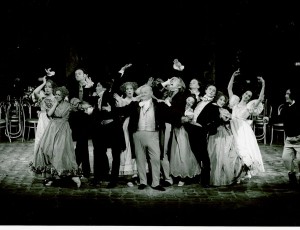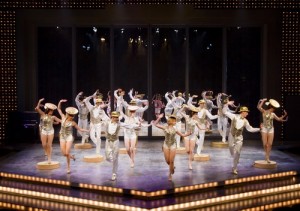
The musical has been around since the mid-nineteenth century. Since about 1866 theatregoers have been packing out auditoriums to see story, song and dance come together. Although opened in 1962, it wasn’t until 1981 that the Chichester Festival Theatre stage brought life to the musical with The Mitford Girls by Caryl Brahms and Ned Sherrin.
The Mitford Girls opened to mixed reviews, some dubbing it ‘marvellous’whilst others preferred the straight acting of the plays they had become used to at their theatre. However, in 1993, the hit show of the season was Pickwick; a musical based on Dickens’Posthumous Papers of the Pickwick Club. Both audience and Theatre staff adored the production and it went on to play at Sadler’s Wells, London.
By offering musicals as well as plays, the Theatre has broadened its range of audience members. This has really helped an already famous name to become even more well-known with many of the more recent musicals transferring to London’s West End and touring the U.K. and even further afield in Canada and New York. It has also given the Festival Theatre a new layer and presented new challenges for staff. For example; when two shows are in repertoire each set will be put in and taken out again after only three or four performances. Plays tend to have a relatively stationary set whereas a musical usually has large revolving scenes and carry on props. All in all, a much more intricate design for the stage crew to move in and out.

The unconventional thrust stage has an impact on the audience from wherever they sit, allowing the performers to be seen from three sides. This enhances the visual effect during the colourful dance routines of traditionally styled musicals such as My One and Only (2001) and 42nd Street (2010), as opposed to the more traditional proscenium arch theatres of the West End. In addition to this, the Vomitoriums, (or ‘Voms’as they are known backstage – these are passages below or behind tiered seats in the auditorium – in the Festival Theatre’s case, these are the entrances and exits to the auditorium that both the audience and performers can use) afford a dynamic element to a performance, whereby the actors can literally ‘spew forth’onto the stage.
Throughout the years Chichester has produced a number of musicals, tending to stick to one big musical in the main house per year, with the exception of 2011 (Singin’ in the Rain and Sweeney Todd).
Since then, Chichester Festival Theatre has continued to awe audiences with trap doors, revolving floors, spiralling staircases, circus sets and even rain on stage. Looking forward to the big musicals of Festival 2014, Guys and Dolls and Gypsy promise to deliver the same marvels and astonishments we all know and love about our Theatre.
Written by Grace Katherine Frean, June 2014
Sources: Chichester Festival Theatre at Fifty by Kate Mosse and the Chichester Festival Theatre Production Archive


